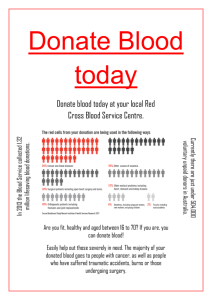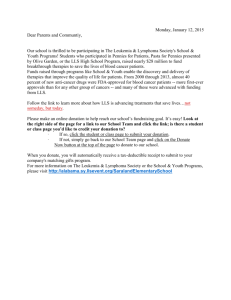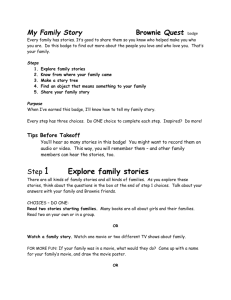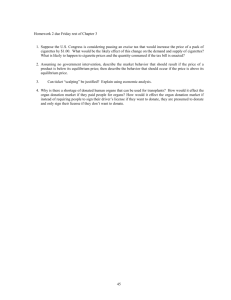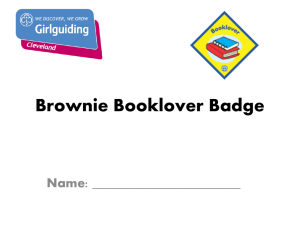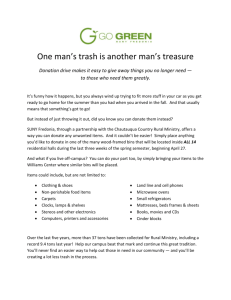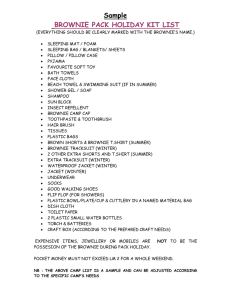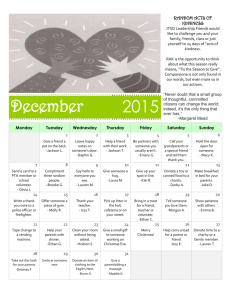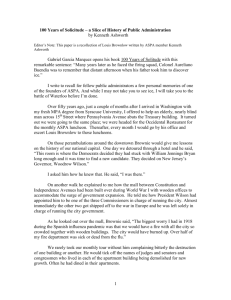Brownie - Philanthropist
advertisement
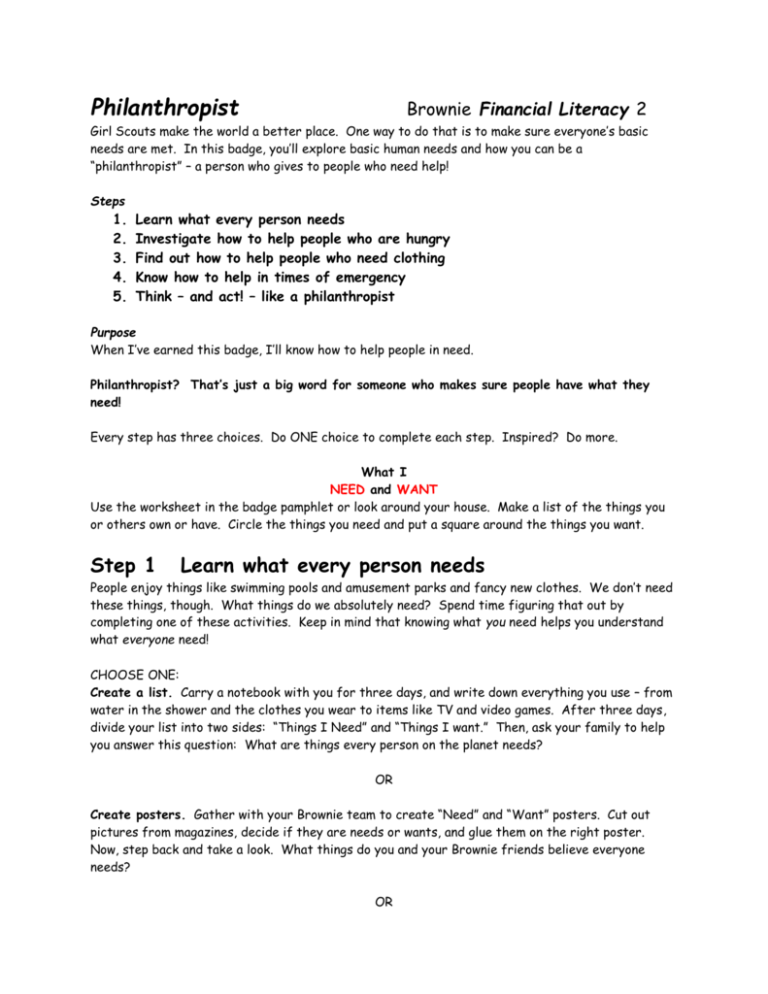
Philanthropist Brownie Financial Literacy 2 Girl Scouts make the world a better place. One way to do that is to make sure everyone’s basic needs are met. In this badge, you’ll explore basic human needs and how you can be a “philanthropist” – a person who gives to people who need help! Steps 1. 2. 3. 4. 5. Learn what every person needs Investigate how to help people who are hungry Find out how to help people who need clothing Know how to help in times of emergency Think – and act! – like a philanthropist Purpose When I’ve earned this badge, I’ll know how to help people in need. Philanthropist? That’s just a big word for someone who makes sure people have what they need! Every step has three choices. Do ONE choice to complete each step. Inspired? Do more. What I NEED and WANT Use the worksheet in the badge pamphlet or look around your house. Make a list of the things you or others own or have. Circle the things you need and put a square around the things you want. Step 1 Learn what every person needs People enjoy things like swimming pools and amusement parks and fancy new clothes. We don’t need these things, though. What things do we absolutely need? Spend time figuring that out by completing one of these activities. Keep in mind that knowing what you need helps you understand what everyone need! CHOOSE ONE: Create a list. Carry a notebook with you for three days, and write down everything you use – from water in the shower and the clothes you wear to items like TV and video games. After three days, divide your list into two sides: “Things I Need” and “Things I want.” Then, ask your family to help you answer this question: What are things every person on the planet needs? OR Create posters. Gather with your Brownie team to create “Need” and “Want” posters. Cut out pictures from magazines, decide if they are needs or wants, and glue them on the right poster. Now, step back and take a look. What things do you and your Brownie friends believe everyone needs? OR Get inspired. Ask an adult in your family or an older Girl Scout to assist you in finding a movie, TV show, or book that can help you understand the needs that everyone shares. Afterwards, write down the top five needs you came up with. Then, ask the person who picked the movie, TV show, or book for their thoughts on your list. Step 2 Investigate how to help people who are hungry Food is a basic human need. Everyone has to eat to be healthy and have energy. The sad truth is many people around the world and in the United States don’t have enough to eat. In this step, start to understand why that is and to find people who help those who don’t have enough to eat. Words Worth Knowing A FOOD BANK is a community place where people can donate food to be shared with others who are hungry. CHOOSE ONE: Do your own research. With an adult’s help, find three groups that help people who need food. Try to find at least one local organization and one global organization. Then, share with friends or family how these organizations help hungry people. OR Take a field trip. There’s probably a food bank in your community. Go on a field trip with your Brownie friends and an adult volunteer to find out more about what they do to help others. OR Invite a guest speaker. Ask someone who works for an organization that helps people who need food. Find out more about why some people don’t have enough to eat and how others are working to make a difference. Question to Ask About Food Most food banks request that food donations be canned or boxed goods. Why? Step 3 Find out how to help people who need clothing Of course, everyone needs clothes! Not just to look nice, but to stay warm in the winter and cool in the summer. Just like food, there are people in the United States and around the world who don’t have enough clothes. Learn how you can help. Questions to Ask About Clothing Are there clothes that you should never donate? Why? CHOOSE ONE: Do your own research. With an adult’s help, use the Internet, library, or local place of worship to find out more about three clothing-based charities. Try to find at least one local organizations and one global organization. Talk with friends and family about how these groups help people get clothes. OR Get secondhand knowledge. It’s good to know about secondhand stores – you can get really good bargains there. Plus, if you have clothes in good condition that you don’t need, you might be able to donate them. That way, someone else can buy them for less money than they would at a store with new items. With an adult’s help, ask an employee at one of these stores to take you on a tour. This can be done solo, or with your entire group. OR Invite a guest speaker. Many clothing-donation groups make house calls – meaning they will stop by to pick up donated items. Invite a volunteer from one of these organizations to talk to your group. Step 4 Know how to help in times of emergency Fires, floods, tornadoes – there are many kinds of emergencies that leave families in need of help. In this step, speak with someone who spends her life helping those affected by emergency situations. CHOOSE ONE: Take a field trip. Nearly every community has at least one organization that helps families in emergency situations. That might mean helping families that are homeless, families with someone in the hospital, or some other emergency. With an adult’s help set up a field trip for your entire group to visit an emergency organization to learn ways to ask for and receive help. OR Invite a guest speaker. Whether it’s a firefighter or a volunteer from the local Red Cross, invite an emergency expert to talk about the different ways to help those in need. If they can’t visit, send them questions via e-mail or talk to them on the phone. OR Find out about helping people around the world. People often travel to other countries to give help where it’s needed. Sometimes faith groups lead these trips, while nonprofit organizations or government groups, such as the Peace Corps, sponsor others. Find someone in your community who helped in this way, and ask them to come and talk to your group about their experiences. Questions to Ask About Emergencies When kids your age go through a disaster like a house fire or flood, what things do they need the most? What things would they like to have that they’ve lost? Step 5 Think – and act! – like a philanthropist After philanthropists learn about the needs people have, they make a plan to help. That might mean donating food, clothing, money, or other supplies. Think back about what you have learned about helping people, and make a plan to be a giver – every little bit helps! CHOOSE ONE: Donate money. Did you find a charity or cause in which you really believe? Then, use your financial skills to save money for a donation. Talk with your family or Brownie friends about setting a reasonable money-saving goal, and decide where you want to donate it. Then, create a plan that will let you save money slowly but surely. For example, if your group saved $1 a week for one year, you’d have more than $50 to donate. OR Organize a great food donation. Team up with your Brownie friends to donate food to a local food bank. Make a shopping list for a meal that a family might enjoy. Assign each Brownie an item to donate. OR Host a clothing-donation party. Host a party either on your own or with your Brownie friends. Instead of gifts, ask each guest to bring a coat or bag of clean clothes to donate. Use what you learned to collect the right kinds of clothes. And, be sure to let everyone know exactly where the donations will be going. How to Give As a philanthropist, you can help others in all kinds of different ways. You can help animals by giving dog and cat food to an animal shelter or the ASPCA. Or, you may find organizations that work to help endangered animals and offer to help them. You can donate toys, games, stuffed animal, and books to a local homeless shelter, police department, or other community organization. Philanthropists also give to organizations that want to heal the planet, make sure people have clean drinking water, or help all children learn to read. And, lots of people give money to the Girl Scouts. They like to help girls like you join the Girl Scouts, have fun, and make a difference. Penny Power In the United States, one penny may not buy much on its own. But the power of many pennies together is huge! Here are some ways young philanthropists have used pennies to make a difference. If you and your Brownie friends want to collect pennies for a cause about which you care, team up with your Girl Scout volunteer to find instructions and great organizations to support online. In 2010, kids collected 2,765,622 pennies to help protect panthers, rebuild marshes in the Gulf of Mexico, and save birds called plovers through the Audubon Society’s Pennies for the Planet. During the 2009-2010 school year, kids working with an organization called Common Cents collected $756,273 in a “penny harvest.”The money went to women’s shelters, animal rights organizations, community gardens and senior centers, and neighborhood service projects. Common Cents was started in 1991 when fourteen-year-old Nora Gross teamed up with her father to figure out how to help a homeless man in her neighborhood! The Leukemia and Lymphoma Society’s Pennies for Patients runs a 3-week program each year where kids can collect change in honor of a local student who survived blood cancer. Since 1994, more than 10 million kids across the country have raised millions of dollars for the program. Add the Badge to Your Journey You can do this badge while you’re on your Journey to help you find ideas for a Take Action project. Now that I’ve earned this badge, I can give service by: Organizing a holiday gift donation program for families in need Teaching Daisies about the importance of giving to others Asking my family to help me set a savings goal in order to make a donation to help others. I’m inspired to:
